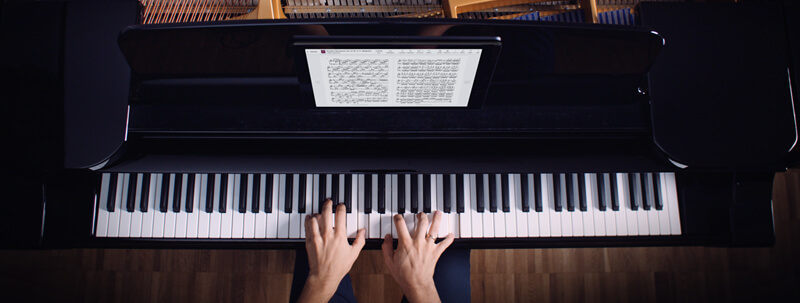How to Play the G-sharp-minor Scale on the Piano - Scales, Chords & Exercises
Jump to section
You get a fascinating chord poster + exclusive content!

The Notes of the G-sharp Minor Scale
The G-sharp minor scale starts out on G-sharp and then goes up using four more sharps - A#, C#, D#, and F#. This tells you that, on your piano, you play five black keys and two white ones: G#-A#-B-C#-D#-E-F#-G#. Its enharmonic "twin" is A-flat minor, which is much more rarely used.

How to Play the G-sharp Minor Scale With the Right Hand (Treble Clef)
On the piano, you can play the G-sharp minor scale going up (toward the higher notes) or coming down. In the treble clef, do this
- Play the following notes going up: G#-A#-B-C#-D#-E-F#-G#. Start playing with your second finger in G#, continue on the A# with your third finger, then tuck your thumb to play the B. Continue up with fingers two and three, then tuck again to play the E with your thumb. Finish with fingers two and three on F# and G# afterward.
- Play the following notes going down: G#-F#-E-D#-C#-B-A#-G#. Now reverse what you've done coming up. Start playing with your third finger on the G# and play down to the first finger on E, then tuck your third finger over the thumb to play the D#, and once you have reached the B, tuck the third finger again to reach the A#. Finish off by playing the G# with your second finger.

How to Play the G-sharp minor Scale With the Left Hand (Bass Clef)
Piano beginners may find it difficult to read and play the left hand. It is worth investing some time to really familiarize yourself with the notes of the B minor scale in the bass clef, and learn how to read them in music scores.
The notes are the same as in the right hand (G#-A#-B-C#-D#-E-F#-G#), but they look different:

This is how you play:
- Going up: Starting with your third finger on G#, play up until your thumb reaches the B. Then tuck your third finger over to play the C# and play until your thumb reaches the next white key, the E. Tuck again and reach the G# with your second finger.
- Coming down: Reverse all of that. Start with your second finger on the high G#, and continue with the third finger on F#. Then tuck your first finger to reach the E, and play down until your third finger reaches the C#. Tuck the thumb again to play the B, and end the scale playing the A# with finger two and the G# with finger three.
The G-sharp minor Key Signature
The key signature, located at the beginning of each line of a piece, lets you see which notes will be raised (#) or lowered (b) consistently throughout that piece.
If you spot this key signature below, the piece is likely in G-sharp minor (or in its parallel Major scale B Major, you'll be able to determine that from the mood of the piece:

6 Exercises to Practice the G-sharp minor Scale
Play one exercise after the other and only move on after having correctly played the previous exercise 5 times on your piano:
- Play the left hand up and down using a metronome and slowly increasing speed
- Play the right hand up and down using a metronome and slowly increasing speed
- Play both hands up and down using a metronome and slowly increasing speed
- Play the left hand up starting from the lowest B to the highest, and down starting from the highest G# to the lowest
- Play the right hand up starting from the lowest G# to the highest, and down starting from the highest G# to the lowest
- Play both hands up starting with the left hand on the lowest G# and stopping when the right hand reaches the highest G#, then play down to the starting position
Why you should exercise scales in general:
- To memorize a scale
- To practice dexterity and intonation (play all keys with even loudness. Beginners often play the notes they work with their stronger fingers much harder. Aim for an even tone)
- To be able to play the scale in time without hesitating to find your fingerings
- To be able to build chords and improvise
G-sharp minor Chords on the Piano
Any minor chord is constructed of three or more notes: The root note - the minor third - the perfect fifth.
In short, what this means for G-sharp minor:
- The basic G-sharp minor chord consists of G#-B-D#.
- The first inversion is B-D#-G#.
- The second inversion is D#-G#-B.
To practice the G-sharp minor chord and inversions, switch from the chord starting with the root note to the first, and the second inversion, starting slowly using a metronome, then increasing your tempo.
10 Popular Pieces in G-sharp minor
- 1 Africa: Toto
- 2 Pictures At An Exhibition: The Old Castle: Modest Mussorgsky
- 3 Sex Bomb: Tom Jones
- 4 Runaway: Aurora
- 5 What's Love Got To Do With It: Tina Turner
- 6 Thank You: Dido
- 7 Etude in G-sharp Minor, S. 141/3 (La Campanella): Franz Liszt
- 8 Kinderszenen, Op. 15 No. 10: Almost too Serious: Robert Schumann
- 9 Cry Me A River: Justin Timberlake
- 10 Fugue 18 G-sharp Minor, BWV 863: Johann Sebastian Bach


